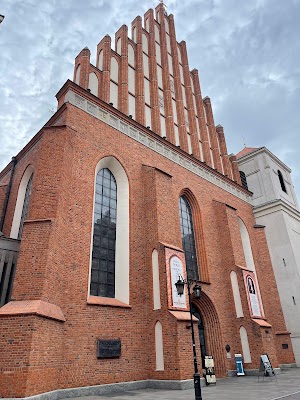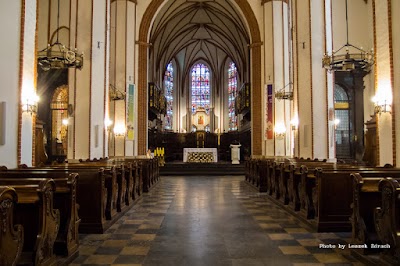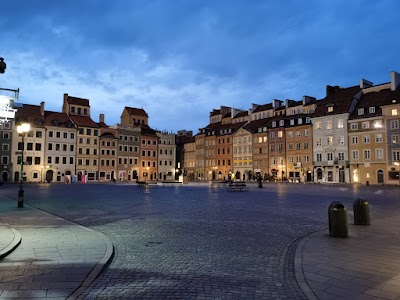St. John's Cathedral (Katedra św. Jana)
Overview
St. John's Cathedral: A Historical Gem in Warsaw
St. John's Cathedral, officially known as the Archcathedral Basilica of St. John the Baptist, stands as a cherished historical landmark in the heart of Warsaw, Poland. This magnificent structure is one of the city's most important religious sites, captivating visitors with its rich history, architectural beauty, and cultural significance. Tourists from all corners of the globe flock to admire its grandeur.
A Journey Through Time
The cathedral's origins date back to the late 14th century, making it one of Warsaw's oldest churches. Initially constructed in the Gothic style, it features a striking red brick facade and intricate vaulted ceilings. Over the centuries, St. John's Cathedral has witnessed many pivotal moments in Poland's history, including royal coronations and times of war. Its most poignant chapter unfolded during World War II when Nazi forces nearly obliterated the structure. Despite the devastation, the cathedral stood resilient, symbolizing the indomitable spirit of Warsaw.
Restoration and Resilience
After the war, an extensive reconstruction effort began, reflecting the Polish people's unwavering commitment to restoring their cultural heritage. Using old photographs, paintings, and historical records as guides, the rebuilding process aimed to revive the cathedral's original Gothic splendor with some Baroque influences. By 1956, St. John's Cathedral was once again a beacon of beauty, showcasing high vaulted ceilings, slender windows, and the timeless elegance of Gothic architecture.
Historical Significance
Beyond its architectural allure, St. John's Cathedral holds tremendous historical importance. It was the site of the coronation of King Stanisław August Poniatowski, the last king of Poland, in 1764. The cathedral also played a vital role in Poland's democratic evolution, hosting the signing of the Constitution of May 3, 1791—one of the world's oldest national constitutions. Additionally, it serves as the final resting place for many distinguished Polish figures, including Nobel Prize-winning author Henryk Sienkiewicz and prominent political leaders.
Interior Wonders
Inside St. John's Cathedral, visitors are greeted by the ornate high altar, richly adorned with exquisite carvings and religious iconography. This altar, which miraculously survived wartime destruction, serves as a focal point, resonating with a sense of sacred history. The cathedral also features several notable chapels, each reflecting unique stylistic elements and historical significance.
Exploring the Crypt and Unique Features
An intriguing aspect of the cathedral is the crypt beneath its floors, which contains the remains of notable Polish leaders and archbishops. This solemn space serves as a reminder of Poland's rich legacy and the enduring influence of its leaders. Another remarkable feature is the intricately designed Gothic pulpit, one of the few original elements to survive the war's devastation.
A Musical Masterpiece
For music enthusiasts, the cathedral houses a magnificent pipe organ dating back to the 17th century. Meticulously restored, this remarkable instrument continues to be used for both religious services and concerts, allowing visitors to experience its majestic tones echoing through the cathedral's hallowed halls.
Location and Nearby Attractions
Conveniently situated in Warsaw's Old Town, a UNESCO World Heritage site, St. John's Cathedral is surrounded by a vibrant area filled with historical monuments, charming cobblestone streets, and picturesque squares. This prime location makes it easy to explore nearby attractions such as the Royal Castle, Market Square, and the Mermaid Statue, each adding to the rich tapestry of Warsaw's cultural landscape.
Enhance Your Visit
To fully appreciate your visit to St. John's Cathedral, consider joining a guided tour. These tours offer insightful narratives about the cathedral's history, architecture, and the pivotal events that have unfolded within its walls. Whether you're contemplative or simply curious, the stories shared by knowledgeable guides will deepen your connection to this historic edifice.
Conclusion: A Symbol of Resilience
In summary, St. John's Cathedral is more than just a religious site; it symbolizes Warsaw's resilience, history, and cultural richness. Its storied past, architectural beauty, and grandeur make it a must-visit landmark in Poland. For international travelers, exploring St. John's Cathedral provides a profound glimpse into the spirit of Warsaw and the enduring legacy of its people.






